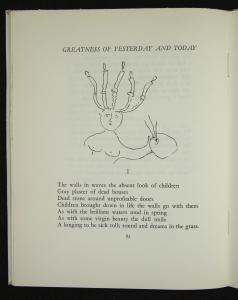

Le dur désir de durer
1. The complaint, and the consolation; or, Night thoughts
2. The Fables of Æesop, and others / With designs on wood, by Thomas Bewick
5. News from nowhere: or, An epoch of rest, being some chapters from Utopian romance
6. The nature of Gothic, a chapter of the stones of Venice
7. Daphnis and Chloe: a most sweet abd pleasant pastoral romance for young ladies
8. The Sphinx
10. Credo
14. Bible.Old Testament. Song of Solomon.
16. Kem byt’? / V. Mai︠a︡kovskiĭ ; ris. N. Shifrin.
17. The ghost in the underblows
19. Bateau ivre
UCLA Call Number: PQ2609.E513 D8

Le dur désir de durer
An image of the frontispiece at the beginning of the translated second half of the book depicts an angel standing next to a table with a bottle of wine, a loaf of bread and knife, and a simple drinking glass.

Le dur désir de durer
An image of the front cover which depicts a figure staring straight at the viewer. In one hand the figure is holding a painter’s palette with brushes. On the figure’s head are five lit candles.
Creator: Eluard, Paul
Publisher:Ward Grey Falcon Press
Publication Place: Philadelphia
Date of Publication: 1950
Dimensions 29 cm
--> Physical Description:
The covers are a smooth, firm bristol paper, with a flat paper binding. The book is light in weight. The book is labeled on the spine with the title, author, and illustrator. The title of the book accompanied by an illustration from Marc Chagall are on the front cover. There are 22 illustrations by Marc Chagall in the book not including the one on the cover. All the illustrations in the book are printed in black ink on paper with the exception of two that were printed in purple. The pages of the book have deckled edges and some are cut. Text blocks are centered with a slightly larger margin towards the outer edge of the page and slighly larger margins on the bottom of the page. Large type size is used.
Provenance:This copy (no. 2 of 300) was likely gifted by Lawrence Clark Powell with the rest of the materials donated by him to the Clark Library Press Collection in 1996. Powell’s bookplate is affixed on the inside front cover.
Condition:
The current condition is very good in wrappers. The pages and cover are both clean and free of any yellowing or other effects of age.
Additional Info:
Number 520 of 1,500 copies, [1st ed.]; An example of the livre d’artiste book. It pairs a well–known artist with a well–known writer who collaborate on a traditionally formatted book of poetry and illustrations. Intended for audiences that are most likely familiar with the respective artists and writers involved.
Interpretation:
This livre d’artiste book is a collaboration between Paul Eluard and artist/painter Marc Chagall. Admission of this book as a planned collaborative effort is on page 61; it reads, “I knew when I wrote these poems that they would be illustrated by the drawings of Marc Chagall.” Also, Eluard has dedicated the first poem to Marc Chagall. By the time of the publication of this book Chagall’s reputation as an artist and as an illustrator was firmly established. As early as the 1920s Chagall had been commissioned by the art dealer Ambroise Vollard for Dead Souls by Nikolai Gogol, and for Fables by Jean de la Fontaine. [Footnote 1] This book might be situated in historical context by understanding that Eluard and Chagall were expressing thoughts and feelings related to their experiences during WWII as is documented in the Translator’s Note, “Certain poems in this volume may appear obscure, unless the reader bears in mind that they were written in the shadow of the German Occupation. Indeed they can scarcely be understood unless they are associated with their historic background of Occupation and Resistance, which merges into the larger struggle of our time, that of the oppressed against the oppressors.”
1. Monica Bohm–Duchen, Marc Chagall (London: Tate Publishing, 2013)
Text Content Description :
Many of the poems depict pairs of people smiling, stars, flashes of light, an abundance of eye contact, skies, oceans, wings, dreams, dissolving of dreams, bodies. The poems are often accompanied by Chagall’s illustrations, which feature a loose lyrical playful style of line and depict such imagery such as people embracing, bird silhouettes with faces coupled together, a nude woman and a man, a sideways giant eyeball, angelic figures. Most of the poems could be interpreted as love poems, or poems about rebirth and renewal, or the experience of being in love and in love with life. A few of the poems seem to have a darker more somber feeling of reflection such as the poem, “Greatness of Yesterday and Today”, which seems to be a remembrance of some of the violence and disparity of WWII.
Contributor: Jonathan Ballak